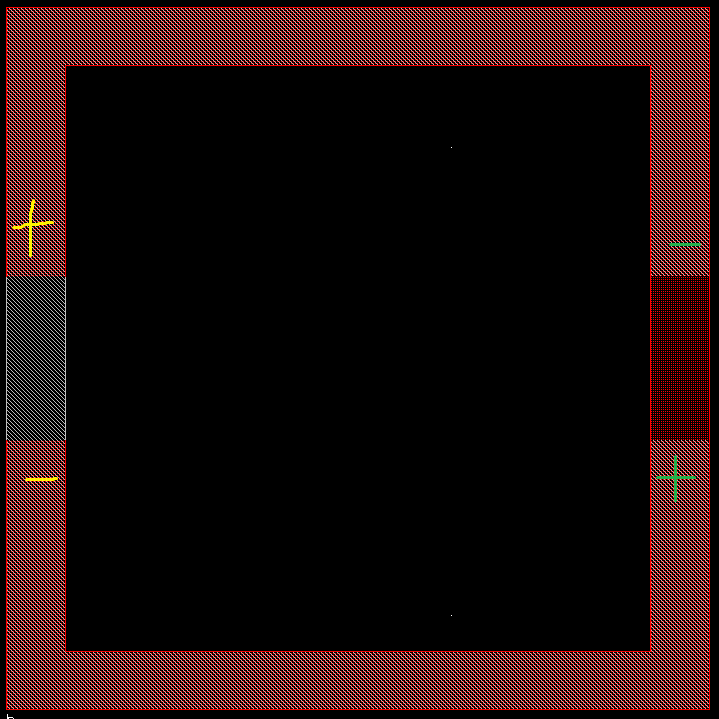Negative coupling coefficient transformer (k)
I am using ASITIC to simulate a transformer which looks like this:

When i calculate the coupling factor between the spirals with the k command, a negative value for K (and M) comes out. Using the k2 command gives a negative mutual inductance as well. Does anyone have an idea why this happens or what does this mean? Should I interpret it like the only coupling is capacitive?
Would appreciate any explanation and tips,
Thanks a lot!
Mutual inductance and K are signed quantities. Flip the terminals of one winding to make it positive...
As far as I know, I cannot switch the terminals in ASITIC, so it calculates it in a "standard" orientation way I assume. The funny thing is, if instead of one turn I draw a 2 turns transformer with the same orientation, the coupling factor becomes positive. What could be the problem then?
Sorry, I don't know your tool details. I even can't read the meaning of your picture in post #1 clearly. But remembering elementary physical law should clarify things. https://en.wikipedia.org/wiki/Induct...ual_inductance
You know that a transformer symbol usually has points indicating the winding direction. The same applies to any transformer or coupled inductors. There is an explicit or implicit winding polarity.
Yes, I am actually aware of that, but I′ve found every definition of k, books and wikipedia included, to be of value between 0 and 1 positive, disregarding the arrange of the transformer points. The arrange on the pic above consists basicaly of 2 metal squares, a red one and a striped white one, each one in different metal layers of a BiCMOS process, so they are vertically coupled. The squares are geometrically inverted with respect to the vertical axis so the red square has its terminals on the left and the white has them on the right. The coupling between them is therefore "inverted" so to say, anyway, the k and M values should be positive in any case I assume.
You should show the coils with indication of positive and negative terminal to make us understand the setup.
In fact k covers the range of -1 to +1.
The polarity of the input coil is like follows (yellow)

The polarity of the output coil (green) is like that due to the geometrical arrange. The mutual inductance and the coupling coefficient should be positive anyways. AFAIK the coupling coefficient "k" can never be negative because it is defined in terms of the mutual inductance M as k = M/sqrt(L1*L2) and M is defined precisely as the theoretical maximum limit that the mutual inductance can have, that is M is always less or equal than the geometrical mean of both inductance sqrt(L1*L2) which cannot be negative. Do you have any reference for the negative k value statement?
Thanks in advance.
The proof that shows the upper limit for M is performed most intuitively through an energy balance, which takes the magnitude of M. Which means if you only care about power delivered across the transformer, you only care about the magnitude of k, not the sign. The mutual inductance M can certainly be negative. For most applications, this doesn't change the results of your device, I think its just a difference between a +90 deg and -90 deg phase change across the transformer. Can't find a good reference on me right this moment, but I think Engineering Circuit Analysis by Hayt has a chapter that describes this in circuit terms decently well.
The explanation by Hayt is actually quite useful, that was the reference I actually took. It states that as long as the device is passive, the M can never be negative, which indeed is the case here. What comes strange for me with this negative result is the fact that if I use 2 turns for each coil and then calculate the mutual inductance the value turns out to be positive indeed. Even if I use a 2:1 ratio the calculated mutual inductance is positive as well, which somehow makes me doubt about the phase difference assumption because the mutual inductance is simply defined in scalar terms of the primary and secondary inductances, which can not be physically negative. It may be a calculation error, but unfortunately have no reference at all and the documentation provides not enough insight. I will try to recalculate k using the Z-Parameters of the transformer and another EM-Simulator. Hope something interestings comes out of it.
Oh, so you're saying that the sign of coupling seems dependent on the number of turns? All sign conventions aside, that is rather odd. What frequency are you operating at? I could imagine parasitics being a problem but that would have to be some pretty odd behavior for a transformer.
Also, here is a source that says M can be positive or negative, but gives no in depth explanation: http://farside.ph.utexas.edu/teachin...s/node102.html
Moreover, I recall now that Microstrip Filters for RF / Microwave Applications by Hong and Lancaster deals very thoroughly with couplings and mixed coupling (capacitive and inductive) in circuits (chapter 7 I believe). This might be handy if you find your transformer has some wild parasitics.
Yes, interestingly this is mentioned in the self inductance rather than the mutual inductance chapter, when the author derives that self inductance L must be necessarily positive. Looks like as he became aware of a previous omission.
I also notice that the Wikipedia article linked by me in post #4 erroneously claims a k range of 0 to 1. I must admit that obvious physical facts may be hidden even to experts. But the same article mentions that M sign must be flipped if you change the transformer current definition.
When analyzing arbitrary conductor configurations, it's impossible to define a "natural" order of coil terminals, so why not simply accept that in the expression uy = Myx*dix/dt Myx can have arbitrary polarities?
Regarding your coil configuration in post #7, if you stack closed conductor loops with same winding direction, you get positive k and M numbers. But your configuration is more like two straight conductors with opposite direction which gives negative k and M.
It should be also mentioned that self and mutual inductance can be only measured in closed conductor loops. Having both terminals of a conductor at different places involves an ambiguity of the analysis because the return path also interacts with the magnetic field. A simulator program might ignore this fact and achieve results that contradicts real live.
The frequency i am working is around 60 GHz, the parasitics do play a significant role and that's why I am using a EM simulator tool to extract somehow a useful circuit model but I assume for that I need a positive mutual inductance, have never found a Picture model or double pi model that uses a negative k. Regarding the coil orientation, while it is true that the polarities of the signals at the primary and the secondary should be 180 degrees out of phase, this does not explain the fact of adding one more coil turn to each side results in a positive M and a positive k. I will use another EM simulator and will try o report on that
An intuitive method to analyze the coupling of conductor configurations qualitatively is to dissect it into straight line segments, determine the coupling to each other conductor segment and sum them. The method can show you why you get negative k for one and positive k for the other configuration.
If you want simulation results consistent with the behavior of real systems, please observe the comment about the necessity to analyze closed loops.
There's nothing wrong with k or M having negative values, so long as you're consistent in your sign conventions.
coupling Negative transformer 相关文章:
- problem: coupling coefficient for two hairpin resonators
- Loose Coupling for a coaxial resonator
- Methods of decreasing the coupling between two closely placed antennas
- Re: Polynomial synthesis in coupling matrix technique
- Capacitive coupling between coaxial and coplanar circular coils
- Increasing stages coupling without increasing capacitance in TRX
